| Sciaphilini | |
|---|---|
 | |
| Scientific classification | |
| Kingdom: | |
| Phylum: | |
| Class: | |
| Order: | |
| Suborder: | |
| Infraorder: | |
| Superfamily: | |
| Family: | |
| Subfamily: | |
| Tribe: | Sciaphilini Sharp, 1891 |
| Genera | |
See text | |
Sciaphilini is a weevil tribe in the subfamily Entiminae.
| Sciaphilini | |
|---|---|
 | |
| Scientific classification | |
| Kingdom: | |
| Phylum: | |
| Class: | |
| Order: | |
| Suborder: | |
| Infraorder: | |
| Superfamily: | |
| Family: | |
| Subfamily: | |
| Tribe: | Sciaphilini Sharp, 1891 |
| Genera | |
See text | |
Sciaphilini is a weevil tribe in the subfamily Entiminae.
Abarypeithes – Alocyrtus – Ameladus – Amicromias – Archeophloeus – Balchaschia – Barypeithes – Brachysomus – Chaetopantus – Chilodrosus – Chiloneus – Chilonorrhinus – Chionostagon – Cyclomias – Cyrtops – Dinas – Dinosius – Edmundia – Euidosomus – Eusomatus – Eusomomorphus – Eusomus – Foucartia – Hypsomias – Mitostylus – Mylacomorphus – Mylochlamys – Ochnodes – Omiocratus – Paophilus – Pareusomus – Platycopes – Pleurodirus – Plochomorphus – Pseudoptochus – Sauromates – Sciaphilomorphus – Sciaphilus – Sciaphobus – Sciomias – Sericopholus – Stasiodis – Svnaptorhinus – Synechops – Tapinomorphus – Tylauchen – Wittmerella – † Archaeosciaphilus

The longhorn beetles are a family of beetles, typically characterized by extremely long antennae, which are often as long as or longer than the beetle's body. In various members of the family, however, the antennae are quite short and such species can be difficult to distinguish from related beetle families such as the Chrysomelidae. The family is large, with over 26,000 species described, slightly more than half from the Eastern Hemisphere. Several are serious pests. The larvae, called roundheaded borers, bore into wood, where they can cause extensive damage to either living trees or untreated lumber. A number of species mimic ants, bees, and wasps, though a majority of species are cryptically colored. The rare titan beetle from northeastern South America is often considered the largest insect, with a maximum known body length of just over 16.7 cm (6.6 in). The scientific name of this beetle family goes back to a figure from Greek mythology: after an argument with nymphs, the shepherd Cerambus was transformed into a large beetle with horns.
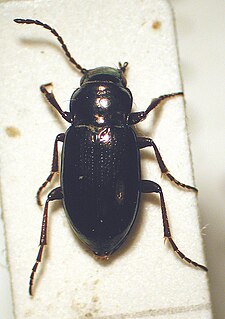
The Trachypachidae are a family of beetles that generally resemble small ground beetles, but that are distinguished by the large coxae of their rearmost legs. There are only six known extant species in the family, with four species of Trachypachus found in northern Eurasia and northern North America, and two species of Systolosoma in Chile. They were much more diverse in the past, with many members belonging to the extinct subfamily Eodromeinae, the first fossils known of this family are of the genera Petrodromeus and Permunda from the Permian-Triassic boundary of Russia.
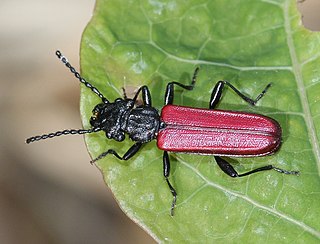
The Cucujidae, "flat bark beetles," are a family of distinctively flat beetles found worldwide under the bark of dead trees. The family has received considerable taxonomic attention in recent years and now consists of 59 species distributed in four genera.

Myxophaga is the second-smallest suborder of the Coleoptera after Archostemata, consisting of roughly 65 species of small to minute beetles in four families. The members of this suborder are aquatic and semiaquatic, and feed on algae.

Scarabaeoidea is a superfamily of beetles, the only subgroup of the infraorder Scarabaeiformia. Around 35,000 species are placed in this superfamily and some 200 new species are described each year. Its constituent families are also undergoing revision presently, and the family list below is only preliminary.

Carl Henrik Boheman was a Swedish entomologist.
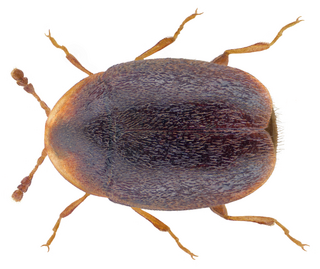
Corylophidae is a family of minute hooded beetles, sometimes called minute fungus beetles, in the order Coleoptera. There are about 18 genera and at least 120 described species in Corylophidae.
Martin Jacoby was an entomologist who specialised in Coleoptera, especially Chrysomelidae.
Smicronyx is a genus of snout and bark beetles in the family Curculionidae. There are at least 70 described species in Smicronyx.

Elmidae, commonly known as riffle beetles, is a family of beetles in the superfamily Byrrhoidea described by John Curtis in 1830. There are more than 150 genera and 1,500 described species in Elmidae.
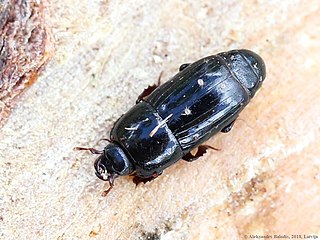
Histerinae is a subfamily of clown beetles in the family Histeridae. There are more than 140 genera and 2,000 described species in Histerinae.
The Anypotactini are a weevil tribe in the subfamily Entiminae.
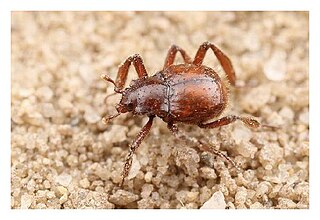
Haeteriinae is a subfamily of clown beetles in the family Histeridae. There are more than 110 genera and 330 described species in Haeteriinae.

Harpalini is a tribe of a diverse group of ground beetles belonging to the subfamily Harpalinae within the broader family Carabidae. The Harpalini tribe contains an estimated 70 genera and subgenera with 357 described species.
Eulichadidae is a family of forest stream beetles in the order Coleoptera. There are about 5 genera and more than 40 described species in Eulichadidae.
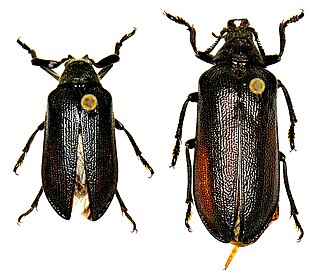
Rhipiceridae is a family of cedar beetles, also known as cicada parasite beetles, in the order Coleoptera. There are about 7 genera and 20 described species in Rhipiceridae.
Mauroniscidae is a family of bark-gnawing, checkered and soft-winged flower beetles in the order Coleoptera. There are at least four genera and about six described species in Mauroniscidae.
Promecheilidae is a family of beetles in the order Coleoptera. There are at least eight genera in Promecheilidae. They were formerly included in a family called Perimylopidae. They are found in South America and New Zealand.

Bromiini is a tribe of leaf beetles in the subfamily Eumolpinae. The tribe contains approximately 120 genera, which are found worldwide. They are generally thought to be an artificial group, often with a subcylindrical prothorax without lateral ridges and covered with setae or scales.
Burmese amber is fossil resin dating to the early Late Cretaceous Cenomanian age recovered from deposits in the Hukawng Valley of northern Myanmar. It is known for being one of the most diverse Cretaceous age amber paleobiotas, containing rich arthropod fossils, along with uncommon vertebrate fossils and even rare marine inclusions. A mostly complete list of all taxa described up until 2018 can be found in Ross 2018; its supplement Ross 2019b covers most of 2019.
| This Curculionidae-related article is a stub. You can help Wikipedia by expanding it. |